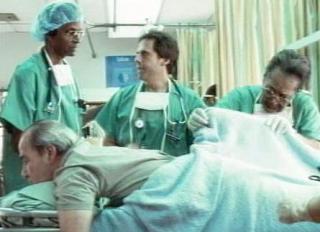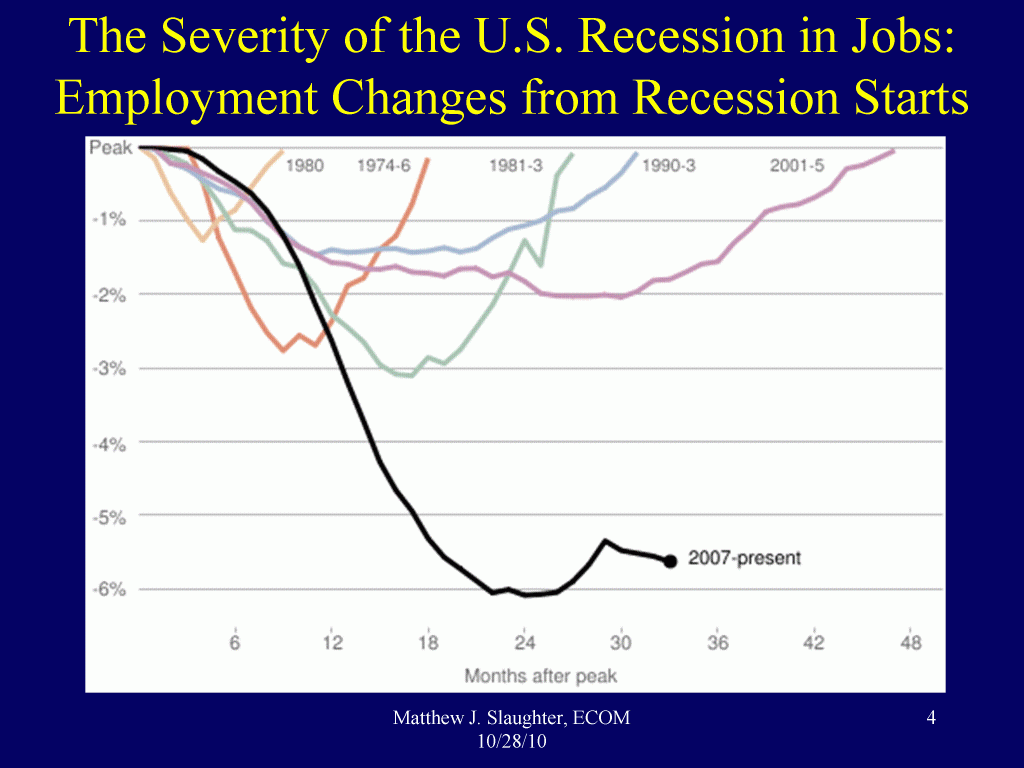Archive for the ‘Robust Economy’ Category
How To Create a Sea of Manufacturing Jobs
 It’s been a long slide from greatness for US manufacturing. It’s been downhill since the 70s – a multi-decade slide. Lately there’s a lot of hype about a manufacturing renaissance in the US – re-shoring, on-shoring, right-shoring. But the celebration misguided. A real, sustainable return to greatness will take decades, decades of single-minded focus, coordination, alignment and hard work – industry, government, and academia in it together for the long haul.
It’s been a long slide from greatness for US manufacturing. It’s been downhill since the 70s – a multi-decade slide. Lately there’s a lot of hype about a manufacturing renaissance in the US – re-shoring, on-shoring, right-shoring. But the celebration misguided. A real, sustainable return to greatness will take decades, decades of single-minded focus, coordination, alignment and hard work – industry, government, and academia in it together for the long haul.
To return to greatness, the number of new manufacturing jobs to be created is distressing. 100,000 new manufacturing jobs is paltry. And today there is a severe skills gap. Today there are unfilled manufacturing jobs because there’s no one to do the work. No one has the skills. With so many without jobs it sad. No, it’s a shame. And the manufacturing talent pipeline is dry – priming before filling. Creating a sea of new manufacturing jobs will be hard, but filling them will be harder. What can we do?
The first thing to do is make list of all the open manufacturing jobs and categorize them. Sort them by themes: by discipline, skills, experience, tools. Use the themes to create training programs, train people, and fill the open jobs. (Demonstrate coordinated work of government, industry, and academia.) Then, using the learning, repeat. Define themes of open manufacturing jobs, create training programs, train, and fill the jobs. After doing this several times there will be sufficient knowledge to predict needed skills and proactive training can begin. This cycle should continue for decades.
Now the tough parts – transcending our short time horizon and finding the money. Our time horizon is limited to the presidential election cycle – four years, but the manufacturing rebirth will take decades. Our four year time horizon prevents success. There needs to be a guiding force that maintains consistency of purpose – manufacturing resurgence – a consistency of purpose for decades. And the resurgence cannot require additional money. (There isn’t any.) So who has a long time horizon and money?
The DoD has both – the long term view (the military is not elected or appointed) and the money. (They buy a lot of stuff.) Before you call me a war hawk, this is simply a marriage of convenience. I wish there was, but there is no better option.
The DoD should pull together their biggest contractors (industry) and decree that the stuff they buy will have radically reduced cost signatures and teach them and their sub-tier folks how to get it done. No cost reduction, no contract. (There’s no reason military stuff should cost what it does, other than the DoD contractors don’t know how design things cost effectively.) The DoD should educate their contractors how to design products to reduce material cost, assembly time, supply chain complexity, and time to market and demand the suppliers. Then, demand they demonstrate the learning by designing the next generation stuff. (We mistakenly limit manufacturing to making, when, in fact, radical improvement is realized when we see manufacturing as designing and making.)
The DoD should increase its applied research at the expense of its basic research. They should fund applied research that solves real problems that result in reduced cost signatures, reduce total cost of ownership, and improved performance. Likely, they should fund technologies to improve engineering tools, technologies that make themselves energy independent and new materials. Once used in production-grade systems, the new technologies will spill into non-DoD world (broad industry application) and create new generation products and a sea of manufacturing jobs.
I think this is approach has a balanced time horizon – fill manufacturing jobs now and do the long term work to create millions of manufacturing jobs in the future.
Yes, the DoD is at the center of the approach. Yes, some have a problem with that. Yes, it’s a marriage of convenience. Yes, it requires coordination among DoD, industry, and academia. Yes, that’s almost impossible to imagine. Yes, it requires consistency of purpose over decades. And, yes, it’s the best way I know.
We must broaden “Design”
Design is typically limited to function – what it does – and is done by engineering (red team). Manufacturing is all about how to make it and is done by manufacturing (blue team). Working separately there is local optimization. We must broad to design to include both – red and blue. Working across red-blue boundaries creates magic. This magic can only be done by the purple team.
Below is my first video post. I hope to do more. Let me know what you think.
The Supreme Court of Technology
 The Founding Fathers got it right with three branches: legislative to make laws; judicial to interpret laws; and executive to enforce them. Back then it was all about laws, and the system worked.
The Founding Fathers got it right with three branches: legislative to make laws; judicial to interpret laws; and executive to enforce them. Back then it was all about laws, and the system worked.
What the Founding Fathers could not realize was there was a powerful, pre-chrysalis force more powerful than laws, whose metamorphosis would exploit a gap in the three branch system. Technology has become a force more powerful than laws, and needs its own branch of government. We need a Supreme Court of Technology. (Think Ph.D. instead of J.D.)
Technology is the underpinning of a sustainable economy, an economy where citizens are well-educated, healthy, and happy, and where infrastructure is safe and supports the citizens’ needs. For countries that have it, technology generates the wealth to pay for education, healthcare, and bridges. Back then it was laws; today it’s technology.
The Founding Fathers knew interpretation of laws demanded consistency, consistency that transcended the election cycle, and, with its lifetime appointment, the Supreme Court was the mechanism. And it’s the same with technology: technology demands consistency of direction and consistency of purpose, and for that reason I propose a Supreme Court of Technology.
The Chief Justice of Technology and her Associate Justices set the long term technology policy for the country. They can be derided for its long time horizon, but they cannot be ousted for making the right decisions or their consistency of purpose. The Justices decide how to best spend their annual budget, which is substantial and adjusts with inflation and population. Since they are appointed for life, the Justices tell Congress how it goes with technology (and to stop with all this gridlock gamesmanship) and ask the President for her plan to implement the country’s technology policy. (Technology transcends political parties and election cycles.)
With the Supreme Court of Technology appointed and their first technology plan in place (think environment and energy), the country is on track to generate wealth sufficient to build the best educational system in the world (think creativity, art, science, math, and problem solving) to fuel the next generation of technology leadership.
Improve the US economy, one company at a time.
 I think we can turn around the US economy, one company at a time. Here’s how:
I think we can turn around the US economy, one company at a time. Here’s how:
To start, we must make a couple commitments to ourselves. 1. We will do what it takes to manufacture products in the US because it’s right for the country. 2. We will be more profitable because of it.
Next, we will set up a meeting with our engineering community, and we will tell them about the two commitments. (We will wear earplugs because the cheering will be overwhelming.) Then, we will throw down the gauntlet; we will tell them that, going forward, it’s no longer acceptable to design products as before, that going forward the mantra is: half the cost, half the parts, half the time. Then we will describe the plan.
On the next new product we will define cost, part count, and assembly time goals 50% less that the existing product; we will train the team on DFMA; we will tear apart the existing product and use the toolset; we will learn where the cost is (so we can design it out); we will learn where the parts are (so we can design them out); we will learn where the assembly time is (so we can design it out).
On the next new product we will front load the engineering work; we will spend the needed time to do the up-front thinking; we will analyze; we will examine; we will weigh options; we will understand our designs. This time we will not just talk about the right work, this time we will do it.
On the next new product we will use our design reviews to hold ourselves accountable to the 50% reductions, to the investment in DFMA tools, to the training plan, to the front-loaded engineering work, to our commitment to our profitability and our country.
On the next new product we will celebrate the success of improved product functionality, improved product robustness, a tighter, more predictable supply chain, increased sales, increased profits, and increased US manufacturing jobs.
On the next new product we will do what it takes to manufacture products in the US because it’s the right thing for the country, and we will be more profitable because of it.
If you’d like some help improving the US economy one company at a time, send me an email (mike@shipulski.com), and I’ll help you put a plan together.
a
p.s. I’m holding a half-day workshop on how to implement systematic cost savings through product design on June 13 in Providence RI as part of the International Forum on DFMA — here’s the link. I hope to see you there.
Missing Element of Lean – Assembly Magazine article
 With its strong focus on waste reduction of processes, lean has been a savior for those who’ve made it out of the great recession. But what’s next? I argue the next level of savings will come from adding a product focus to lean’s well-developed process focus. For the complete Assembly Magazine article (one page), click here.
With its strong focus on waste reduction of processes, lean has been a savior for those who’ve made it out of the great recession. But what’s next? I argue the next level of savings will come from adding a product focus to lean’s well-developed process focus. For the complete Assembly Magazine article (one page), click here.
Money out the wazoo
 There’s a huge untapped source of profits out there – a virtual gold mine – with profit opportunities so large you can’t see them, and if you do see them, too large to believe. These profits larger than you’ve achieved with your traditional lean work. (Actually, what I’m talking about the next evolution of lean.) Want to see what I’m talking about? Go to your factory and watch. The gold mine will be hiding in plain sight – it’s your product.
There’s a huge untapped source of profits out there – a virtual gold mine – with profit opportunities so large you can’t see them, and if you do see them, too large to believe. These profits larger than you’ve achieved with your traditional lean work. (Actually, what I’m talking about the next evolution of lean.) Want to see what I’m talking about? Go to your factory and watch. The gold mine will be hiding in plain sight – it’s your product.
Huge savings blah, blah, blah. How significant? Here’s the formula:
material cost x volume x 50%.
Now, for your highest volume product, do the calculation. Go ahead. Do it. Humor me. It’s worth it.
Go get your best pen, and calculate by hand. Write down the number. Go ahead. Write it down, but make sure you put the dollar sign in front, and, please, put in the commas. Don’t abbreviate thousands, millions, or billions (or trillions, Mr. Gates) – write the zeros. All of them.
There. You did it. Not so hard. Now, sit quietly, and contemplate the number. Look at it for an hour. Don’t say anything, just sit with it.
Now, get bigger piece of paper, and re-run the calculation, but this time write big. Repeat with a poster board, and finish with your biggest whiteboard – big zeros, lot’s of them. (Don’t forget the commas.) Marinate for an hour. Don’t say anything, just sit.
Now that you appreciate the significance of the number, go make something happen. If you’re a CEO, tell your engineering leader to do DFMA; if you’re the manufacturing leader, grab your engineering leader by the ear, and walk to the whiteboard; if you’re the engineering leader, do DFMA.
You likely don’t believe the number. I know. It’s okay. But, a number that big at least deserves a Google search: save 50% with DFMA.
Work that creates wealth
 Today’s biggest problems are difficult to solve and our approach to solving them isn’t helping. Whether it’s healthcare, education, infrastructure, defense, or the economy we never get past the wrong question: “Who’s going to pay for it?
Today’s biggest problems are difficult to solve and our approach to solving them isn’t helping. Whether it’s healthcare, education, infrastructure, defense, or the economy we never get past the wrong question: “Who’s going to pay for it?
With healthcare we argue about costs and taxes – who pays and how much. But we’ve got to move past that argument. The real deal is we create insufficient wealth. (Our inability to pay for healthcare is a symptom.) So the real solution must focus on work that creates wealth, real wealth. I’m not talking about merger and acquisition wealth. I’m talking about real wealth generated by inventing, designing, and making products. I’m talking about manufacturing – creating products out of dirt, rocks, and sticks and selling them for more than the cost to make them. With more manufacturing we can fix healthcare. (I also think we should look deeply at the work of providing healthcare and improve the work.)
With education we argue about costs and taxes – who pays and how much. But we’ve got to move past that argument. The real deal is we create insufficient wealth. (Our inability to pay for education is a symptom.) So the real solution must focus on work that creates wealth, real wealth. I’m not talking about merger and acquisition wealth. I’m talking about real wealth generated by inventing, designing, and making products. I’m talking about manufacturing — creating products. With more manufacturing we can fix education. (I also think we should look deeply at the work of providing education and improve the work.)
With infrastructure we argue about costs and taxes – who pays and how much. But we’ve got to move past that argument. The real deal is we create insufficient wealth. (Our inability to pay for infrastructure is a symptom.) So the real solution must focus on work that creates wealth, real wealth. I’m talking about real wealth generated by inventing, designing, and making products. I’m talking about manufacturing — creating products. With more manufacturing we can fix our infrastructure. (I also think we should look deeply at the work of creating and maintaining infrastructure and improve it.)
With defense we argue about costs and taxes – who pays and how much. But we’ve got to move past that argument. The real deal is we create insufficient wealth. (Our inability to pay for defense is a symptom.) So the real solution must focus on work that creates wealth, real wealth. I’m talking about manufacturing — creating products. With more manufacturing we can fix defense. (I also think we should improve the work of providing defense.)
Pulling it all together, with the economy we argue about taxes – who pays and how much. But we’ve got to move past that argument. The real deal is we create insufficient wealth. (Our economy’s health is a symptom.) So the real solution must focus on work that creates real wealth. I’m talking about manufacturing. With more manufacturing the economy will fix itself.
Thankfully we all have different views on healthcare, education, infrastructure, and defense, and I want to preserve them. (That’s what makes our country great.) However, I think we can all agree that creating more wealth will improve our chances of fixing our big problems.
Let’s do more manufacturing.
A Unifying Theory for Manufacturing?
 The notion of a unifying theory is tantalizing – one idea that cuts across everything. Though there isn’t one in manufacturing, I think there’s something close: Design simplification through part count reduction. It cuts across everything – across-the-board simplification. It makes everything better. Take a look how even HR is simplified.
The notion of a unifying theory is tantalizing – one idea that cuts across everything. Though there isn’t one in manufacturing, I think there’s something close: Design simplification through part count reduction. It cuts across everything – across-the-board simplification. It makes everything better. Take a look how even HR is simplified.
HR takes care of the people side of the business and fewer parts means fewer people – fewer manufacturing people to make the product, fewer people to maintain smaller factories, fewer people to maintain fewer machine tools, fewer resources to move fewer parts, fewer folks to develop and manage fewer suppliers, fewer quality professionals to check the fewer parts and create fewer quality plans, fewer people to create manufacturing documentation, fewer coordinators to process fewer engineering changes, fewer RMA technicians to handle fewer returned parts, fewer field service technicians to service more reliable products, fewer design engineers to design fewer parts, few reliability engineers to test fewer parts, fewer accountants to account for fewer line items, fewer managers to manage fewer people.
Before I catch hell for the fewer-people-across-the-board language, product simplification is not about reducing people. (Fewer, fewer, fewer was just a good way to make a point.) In fact, design simplification is a growth strategy – more output with the people you have, which creates a lower cost structure, more profits, and new hires.
A unifying theory? Really? Product simplification?
Your products fundamentally shape your organization. Don’t believe me? Take a look at your businesses – you’ll see your product families in your org structure. Take look at your teams – you’ll see your BOM structure in your org structure. Simplify your product to simplify your company across-the-board. Strange, but true. Give it a try. I dare you.
I don’t know the question, but the answer is jobs.
 Some sobering facts: (figure and facts from Matt Slaughter)
Some sobering facts: (figure and facts from Matt Slaughter)
- During the Great Recession, US job loss (peak to trough) was 8.4 million payroll jobs were lost (6.1%) and 8.5 million private-sector jobs (7.3%).
- In Sept. 2010 there were 108 million U.S. private-sector payroll jobs, about the same as in March 1999.
- It took 48 months to regain the lost 2.0% of jobs in the 2001 recession. At that rate, the U.S. would again reach 12/07 total payroll jobs around January 2020.
The US has a big problem. And I sure as hell hope we are willing do the hard work and make the hard sacrifices to turn things around.
To me it’s all about jobs. To create jobs, real jobs, the US has got to become a more affordable place to invent, design, and manufacture products. Certainly modified tax policies will help and so will trade agreements to make it easier for smaller companies to export products. But those will take too long. We need something now.
To start, we need affordability through productivity. But not the traditional making stuff productivity, we need inventing and designing productivity.
Here’s the recipe: Invent technology in-country, design and develop desirable products in-country (products that offer real value, products that do something different, products that folks want to buy), make the products in-country, and sell them outside the country. It’s that straightforward.
To me invention/innovation is all about solving technical problems. Solving them more productively creates much needed invention/innovation productivity. The result: more affordable invention/innovation.
To me design productivity is all about reducing product complexity through part count reduction. For the same engineering hours, there are few things to design, fewer things to analyze, fewer to transition to manufacturing. The result: more affordable design.
Though important, we can’t wait for new legislation and trade agreements. To make ourselves more affordable we need to increase productivity of our invention/innovation and design engines while we work on the longer term stuff.
If you’re an engineering leader who wants more about invention/innovation and or design productivity, send me an email at
and use the subject line to let me know which you’re interested in. (Your contact information will remain confidential and won’t be shared with anyone. Ever.)
Together we can turn around the country’s economy.
A Call To Arms for Engineers
 Engineers make magic. We are the only ones who create things from nothing: cars, televisions, bridges, buildings, machine tools, molecules, software… (You get the idea.) Politicians can’t do it, lawyers can’t do it, MBAs can’t do it. Only engineers.
Engineers make magic. We are the only ones who create things from nothing: cars, televisions, bridges, buildings, machine tools, molecules, software… (You get the idea.) Politicians can’t do it, lawyers can’t do it, MBAs can’t do it. Only engineers.
And the stuff we create is the foundation of sustainable economies. We create things, our companies sell them for a profit, and that profit creates wealth and fuels our economies – a tight causal chain. Said another way: no engineers, no products, no profits, no wealth, no economy. The end.
Engineers used to be valued for our magic. In medieval times we were given high status for our art, for making stuff that mattered: swords, trebuchets, armor, castles… (You get the idea.) And the best of us were given a special title (wizard) and special consideration (if not reverence) for our work. These folks were given a wide berth, and for good reason. Piss them off and they’d turn someone into a toad, or worse yet, stop making the stuff that mattered.
In the industrial revolution we were valued for our magic, for making stuff that mattered. This time it was the machines that made machines and weapons: water powered factories, gun drills, lathes, grinding machines, honing machines… (You get the idea.) Politicians used our magic to advance their causes and industrialists got rich on our magic, and our status was diminished.
Since then we’ve made more magic than ever: cars, televisions, bridges, buildings, machine tools, molecules, software… (You get the idea.) We still make magic yet have little influence over our how our companies do things. How did we let this happen? We forgot that we make magic.
We forgot our magic is valuable and powerful (and scary). We forgot that without our magic the wheels fall off. No magic, no profit, no economy.
Engineers – A call to arms! It’s time recognize our magic is still as powerful as Merlin’s and it’s time to behave that way again. Watch out politicians, lawyers, and MBAs or we’ll turn you into toads.
Manufacturing!

Manufacturing creates value to pay for schools.
A

Manufacturing creates value to pay for healthcare.
A

Manufacturing creates value to build and maintain infrastructure.
A

Manufacturing creates value to pay mortgages.
A

Manufacturing creates jobs.
 Mike Shipulski
Mike Shipulski